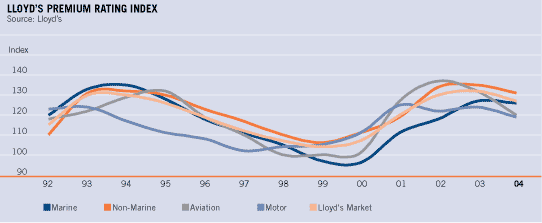|
|
|
|
|
 |
OPERATING AND FINANCIAL REVIEW / BUSINESS CONTEXT / TRADING ENVIRONMENT

 |
| TRADING BACKGROUND |
 |
With the extremely favourable pricing
environment which prevailed through 2002 and
2003, by the end of 2003 the non-life insurance
industry had repaired much of the damage done
to its capital during the trough of the last cycle
and the 11 September 2001 terrorist attacks.
Additionally, the Bermudian start-ups of 2001
had experienced two excellent years of trading
and were seeking to use their increased capacity.
Insurance company capital and surplus is a
measure of underwriting capacity.
US and UK Capital & Surplus graph
In the United States, Amlin’s biggest market,
total capital and surplus rose by 6.3%, or
US$22 billion, during the first nine months
of 2004. While this is 22% higher than
at the end of 1999, the US economy has
expanded by approximately 25% over the same
period and demand for insurance along with it.
Nevertheless, balance sheet growth and
increased evidence of exceptionally strong
margins in many areas contributed to an
erosion of pricing power and rates reduced
from the peaks reached in 2003, with most
pressure being experienced on large
commercial property risks. It remained,
however, a very healthy market.
In the UK, Amlin’s second largest market, the
capital and surplus of the UK non-life and
composite sector had not recovered to the same
extent as in the United States and this was
reflected in generally less pressure on rates,
although by the year end there were signs of
growing competition. These conditions in both
the United States and the UK are reflected in
Lloyd’s premium rating index below.

Against this background, Amlin experienced
another year of highly satisfactory trading
conditions with an average renewal rate
reduction across the portfolio of only 4%
and an overall retention ratio of 79%. In the
first two months of 2005, while increased
competition is being witnessed in a number
of areas such as international property
catastrophe reinsurance and large commercial
property risks, most classes have so far
remained disciplined and this has resulted in
average renewal rate reductions across the
portfolio for the January renewals of only 4%.
|
|
|
|
|

|
  |
|
|
|
|